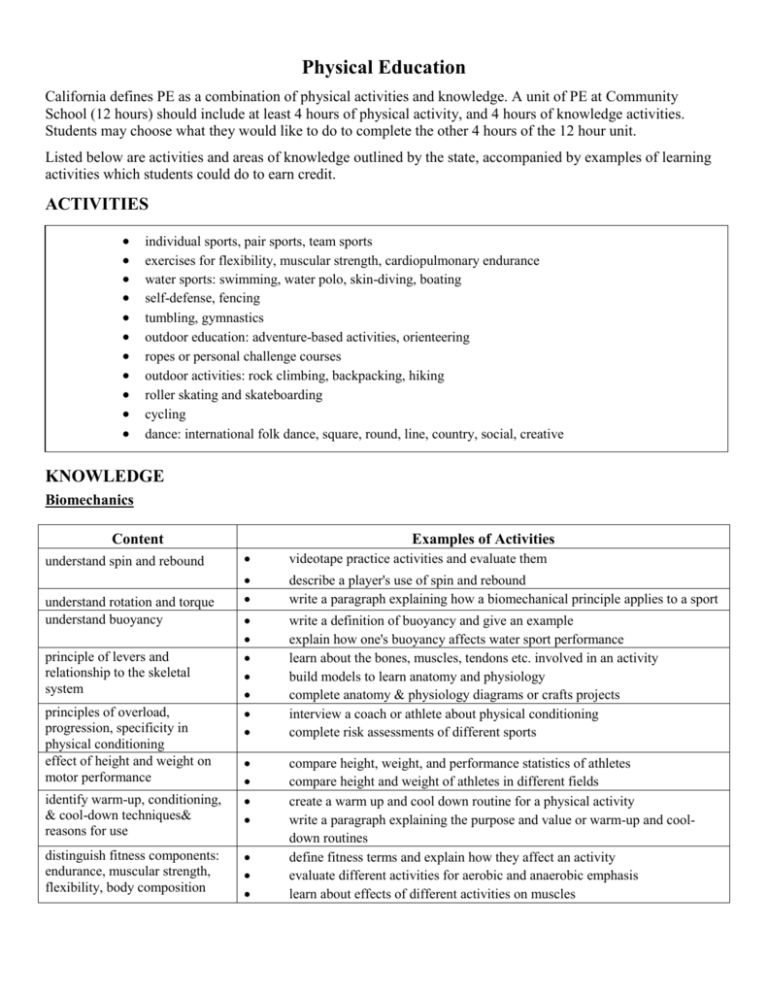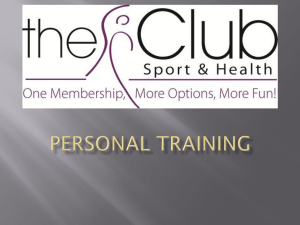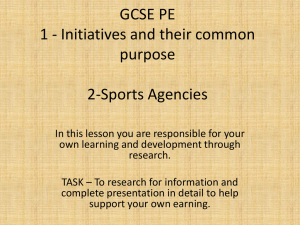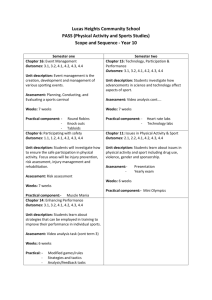Physical Education Contract Standards
advertisement

Physical Education California defines PE as a combination of physical activities and knowledge. A unit of PE at Community School (12 hours) should include at least 4 hours of physical activity, and 4 hours of knowledge activities. Students may choose what they would like to do to complete the other 4 hours of the 12 hour unit. Listed below are activities and areas of knowledge outlined by the state, accompanied by examples of learning activities which students could do to earn credit. ACTIVITIES individual sports, pair sports, team sports exercises for flexibility, muscular strength, cardiopulmonary endurance water sports: swimming, water polo, skin-diving, boating self-defense, fencing tumbling, gymnastics outdoor education: adventure-based activities, orienteering ropes or personal challenge courses outdoor activities: rock climbing, backpacking, hiking roller skating and skateboarding cycling dance: international folk dance, square, round, line, country, social, creative KNOWLEDGE Biomechanics Content understand spin and rebound understand rotation and torque understand buoyancy principle of levers and relationship to the skeletal system principles of overload, progression, specificity in physical conditioning effect of height and weight on motor performance identify warm-up, conditioning, & cool-down techniques& reasons for use distinguish fitness components: endurance, muscular strength, flexibility, body composition Examples of Activities videotape practice activities and evaluate them describe a player's use of spin and rebound write a paragraph explaining how a biomechanical principle applies to a sport write a definition of buoyancy and give an example explain how one's buoyancy affects water sport performance learn about the bones, muscles, tendons etc. involved in an activity build models to learn anatomy and physiology complete anatomy & physiology diagrams or crafts projects interview a coach or athlete about physical conditioning complete risk assessments of different sports compare height, weight, and performance statistics of athletes compare height and weight of athletes in different fields create a warm up and cool down routine for a physical activity write a paragraph explaining the purpose and value or warm-up and cooldown routines define fitness terms and explain how they affect an activity evaluate different activities for aerobic and anaerobic emphasis learn about effects of different activities on muscles Movement Skills and Knowledge Content Examples of Activities keep a written chart of personal progress in an activity make a videotape during activity and evaluate performance watch a game and keep statistics make a chart on graph paper or the computer challenge personal best in skill development pre and post test of skills take heart rate at intervals during an activity & chart it teach someone to find and calculate heart rate write a paragraph describing a performance and how ideas and feelings are communicated describe the aesthetic qualities of movement describe the difference between violations and fouls describe the aesthetic qualities of a performance create a piece of art which expresses the aesthetic qualities of a performance summarize and explain the rules and strategies of a sport define violations and fouls in a game or sport define game rules, why they exist, what skills they promote measure performance in terms of technique, accuracy, distance, speed chart own motor skill development learn to calculate individual heart rate describe ways to use movement to communicate ideas or feelings Health Content Examples of Activities impact of exercise, relaxation, nutrition, stress, substance abuse on ability to do physical exercise importance of appropriate intensity of exercise and heart rate describe long-term physiological, psychological and other benefits of physical activity explain the social, personal and health benefits of skills in sports, games and dance interrelationship of health fitness activities and optimum health read about exercise, relaxation, nutrition, or substance abuse. Describe how it affects physical exercise ability change your eating habits for a week and observe how you feel and perform interview an athlete or health professional about exercise intensity and heart rate research physical fitness testing and history research sports injuries, precautions, preventions, therapy find internet information on long-term physical fitness benefits research effect of exercise on heart, lungs, bones, mood, immune system, weight, sexual vitality, or social life write a report on the history of a sport or physical activity interview a dancer or athlete about the impact of the activity on their life read an internet article about fitness define the health benefits of specific sports or activities research health impacts of drugs, steroids, tobacco, alcohol Consumer and Career Information Content evaluate cost-effectiveness of exercise programs offered consumers know about career opportunities in physical education and related fields evaluate claims in ads for commercial products and programs Examples of Activities compare prices & services of local fitness clubs and gyms interview a worker in sports, recreation or health. research working in a PE or health field describe and evaluate an advertisement SOCIAL AND PERSONAL DEVELOPMENT Possible Activities Content accept and respect decisions made by game officials accept responsibility for own behavior resolve individual and group conflicts with physical activities recognize difference between ethical and unethical behavior appreciate importance of fair play, cooperation, competition in team activities be able to cooperate rather than dominate and share leadership acknowledge and respect stylistic differences in performance work for delayed rewards and persevere toward a goal complete a self evaluation of performance in a sport or activity •discuss personal responsibility with a younger child •write a description of a conflict and how it was resolved •write commentary about an ethical decision in a sport or activity •evaluate sportsmanship and cooperation among members of a team or activity group •write a paragraph describing the leadership roles of members of a game observe two people and compare their differences in style and performance compare rules, equipment, setting for men's and women's sports read and comment about a well-known athlete's history and personal goals teach someone a sport or activity make up a game or sport write a review of a performance create a piece of art which reflects cultural values in a performance you watched research the history of a sport or activity write about a famous athlete or performer write about the historical evolution of sports, equipment, and attire research legislation about equity issues in sports research history and development of Olympic sports write a paragraph evaluating your own strengths and limitations in a sport or activity referee a game. Describe some of the decisions you made and why write a set of sportsmanship guidelines for a sport or game Try a sport or physical activity which is new to you. Write a paragraph describing what you thought of it Research social sacrifices of athletes set personal goals for health and fitness through physical exercise keep a physical fitness goals journal conduct a survey about activities of others evaluate personal performance understand the importance of repeat and practice to achieve excellence write a description of your strengths and areas for improvement in a sport or activity create a practice routine for a sport or activity compare and contrast professional and amateur athletes assume leadership role as peer or other coach appreciate movement as an art form that reflects cultural values understand the historical role of games, sports, and dance in the cultural life of a population accept own limitations develop appreciation for and skills in cooperation, fair play, group rules evaluate personal needs, interests and capacities for movement choices








